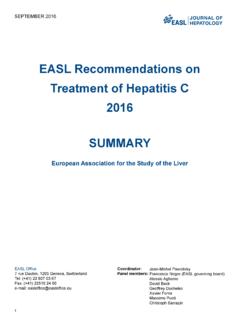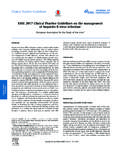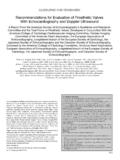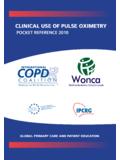Transcription of EASL-ALEH Clinical Practice Guidelines: Non …
1 EASL-ALEH Clinical Practice guidelines : Non- invasive testsfor evaluation of liver disease severity and prognosisEuropean Association for the Study of the Liver ,Asociaci n Latinoamericana para el Estudio del H gadoIntroductionLiver fibrosis is part of the structural and functional alterations inmost chronic liver diseases. It is one of the main prognostic fac-tors as the amount of fibrosis is correlated with the risk of devel-oping cirrhosis and liver-related complications in viral and non-viral chronic liver diseases [1,2]. Liver biopsy has traditionallybeen considered the reference method for evaluation of tissuedamage such as hepatic fibrosis in patients with chronic liver dis-ease. Pathologists have proposed robust scoring system for stag-ing liver fibrosis such as the semi-quantitative METAVIR score[3,4]. In addition computer-aided morphometric measurementof collagen proportional area, a partly automated technique, pro-vides an accurate and linear evaluation of the amount of fibrosis[5].
2 Liver biopsy gives a snapshot and not an insight into thedynamic changes during the process of fibrogenesis (progression,static or regression). However, immunohistochemical evaluationof cellular markers such as smooth muscle actin expression forhepatic stellate cell activation, cytokeratin 7 for labeling ductularproliferation or CD34 for visualization of sinusoidal endothelialcapillarization or the use of two-photon and second harmonicgeneration fluorescence microscopy techniques for spatial assess-ment of fibrillar collagen, can provide additional functional information [6,7]. All these approaches are valid provided thatthe biopsy is of sufficient size to represent the whole liver [4,8].Indeed, liver biopsy provides only a very small part of the wholeorgan and there is a risk that this part might not be representa-tive for the amount of hepatic fibrosis in the whole liver due toheterogeneity in its distribution [9].
3 Extensive literature hasshown that increasing the length of liver biopsy decreases therisk of sampling error. Except for cirrhosis, for which micro-frag-ments may be sufficient, a 25 mm long biopsy is considered anoptimal specimen for accurate evaluation , though 15 mm is con-sidered sufficient in most studies [10]. Not only the length butalso the caliber of the biopsy needle is important in order toobtain a piece of liver of adequate size for histological evaluation ,with a 16 gauge needle being considered as the most appropriate[11] to use for percutaneous liver biopsy. Interobserver variationis another potential limitation of liver biopsy which is related tothe discordance between pathologists in biopsy interpretation,although it seems to be less pronounced when biopsy assessmentis done by specialized liver pathologists [12]. Beside technicalproblems, liver biopsy remains a costly and invasive procedurethat requires physicians and pathologists to be sufficientlytrained in order to obtain adequate and representative results this again limits the use of liver biopsy for mass screening.
4 Lastbut not least, liver biopsy is an invasive procedure, carrying a riskof rare but potentially life-threatening complications [13,14].These limitations have led to the development of non-invasivemethods for assessment of liver fibrosis. Although some of thesemethods are now commonly used in patients for first lineassessment, biopsy remains within the armamentarium ofhepatologists when assessing the etiology of complex diseasesor when there are discordances between Clinical symptoms andthe extent of fibrosis assessed by non- invasive considerations when using non- invasive testsThe performance of a non- invasive diagnostic method isevaluated by calculation of the area under the receiver operatorcharacteristic curve (AUROC), taking liver biopsy as the referencestandard. However, biopsy analysis is an imperfect referencestandard: taking into account a range of accuracies of the biopsy,even in the best possible scenario, an AUROC > cannot beachieved for a perfect marker of liver disease [15].
5 The AUROCcan vary based on the prevalence of each stage of fibrosis,described as spectrum bias [16]. Spectrum bias has importantimplications for the study of non- invasive methods, particularlyin comparison of methods across different study populations. Ifextreme stages of fibrosis (F0 and F4) are over-represented in apopulation, the sensitivity and specificity of a diagnostic methodwill be higher than in a population of patients that haspredominantly middle stages of fibrosis (F1 and F2). Several waysof preventing the spectrum bias have been proposed includingthe adjustment of AUROC using the DANA method (standardiza-tion according to the prevalence of fibrosis stages that defineadvanced (F2 F4) and non-advanced (F0 F1) fibrosis) [17,18] orthe Obuchowski measure (designed for ordinal gold standards)[19]. What really matters in Clinical Practice is the number ofpatients correctly classified by non- invasive methods for adefined endpoint according to the reference standard ( truepositive and true negative).
6 Journal of Hepatology2015vol. 63j237 264 Received 9 April 2015; accepted 9 April 2015 Chairmen:Laurent Castera & Henry Lik Yuen Chan (EASL), Marco Arrese (ALEH). Clinical Practice guidelines Panel members:Nezam Afdhal, Pierre Bedossa, MireenFriedrich-Rust, Kwang-Hyub Han, Massimo Pinzani. Correspondence: EASL Office, 7 rue Daubin, CH 1203 Geneva, Switzerland. Tel.:+41 22 807 0360; fax: +41 22 328 Practice GuidelinesGeneral statements Even though liver biopsy has been used as the referencemethod for the design, evaluation and validation ofnon- invasive tests, it is an imperfect gold standard. Inorder to optimize the value of liver biopsy for fibrosisevaluation, it is important to adhere to the followingrecommendations: (i) sample length >15 mm by a 16 Gneedle; (ii) use of appropriate scoring systems accordingto liver disease etiology; and (iii) reading by an experi-enced (and if possible specialized) pathologist.
7 Non- invasive tests reduce but do not abolish the need forliver biopsy; they should be used as an integrated systemwith liver biopsy according to the Clinical Practice guidelines (CPGs) have been developed bya panel of experts chosen by the EASL and ALEH GoverningBoards. The recommendations were peer-reviewed by externalexpert reviewers and approved by EASL and ALEH GoverningBoards. The CPGs were established using data collected fromPubMed and Cochrane database searches. The CPGs have beenbased, as far as possible, on evidence from existing publications,and, if evidence was unavailable, the experts provide personalexperiences and opinion. When possible, the level of evidenceand recommendation are cited. The evidence and recommenda-tions in these guidelines have been graded according to theGrading of Recommendations Assessment, Development andEvaluation (GRADE) system.
8 The strength of recommendationsthus reflects the quality of underlying evidence. The principlesof the GRADE system have been enunciated [20]. The quality ofthe evidence in the CPG has been classified into one of threelevels: high (A), moderate (B) or low (C). The GRADE systemoffers two grades of recommendation: strong (1) or weak (2)(Table 1). The CPGs thus consider the quality of evidence: thehigher the quality of evidence, the more likely a strong recom-mendation is warranted; the greater the variability in valuesand preferences, or the greater the uncertainty, the more likelya weaker recommendation is non- invasive tests CPG Panel has considered the followingquestions:What are the currently available non- invasive tests?What are the endpoints for staging liver fibrosis?How do serum biomarkers perform for staging liver fibrosis?Do patented and non-patented serum biomarkers performdifferently?
9 How does transient elastography (TE) perform for stagingliver fibrosis?How do novel elastography methods perform compared to TEfor staging liver fibrosis?How does TE perform compared to serum biomarkers for stag-ing liver fibrosis?What is the added value of combining TE and serumbiomarkers?What are the indications for non- invasive tests for stagingliver disease in viral hepatitis?What are the indications for non- invasive tests for stagingliver disease in non-alcoholic fatty liver disease (NAFLD)?What are the indications for non- invasive tests for stagingliver disease in other chronic liver diseases?How should non- invasive tests be used when deciding fortreatment in viral hepatitis?Is there a use for non- invasive tests when monitoring treat-ment response in viral hepatitis?Is there a use for non- invasive tests when monitoring diseaseprogression in chronic liver diseases?
10 What is the prognostic value of non- invasive tests in chronicliver disease?GuidelinesCurrently available non- invasive methodsNon- invasive methods rely on two different approaches: a bio-logical approach based on the quantification of biomarkers inserum samples or a physical approach based on the measure-ment of liver stiffness (LS). Although these approaches are com-plementary, they are based on different rationales. Serumbiomarkers indicate several, not strictly liver specific clinicaland serum parameters that have been associated with fibrosisstage, as assessed by liver biopsy, whereas LS corresponds to agenuine and intrinsic physical property of liver biomarkers of liver fibrosisMany serum biomarkers have been proposed for staging liverfibrosis, mainly in patients with chronic hepatitis C. They areTable grading used for the EASL-ALEH guidelines (adapted from the GRADE system).
















